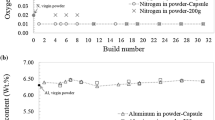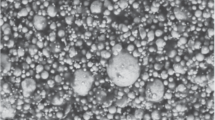Abstract
In the applications of powder injection moulding (PIM), the metallic powders are the most popular material. In our study, three metallic powders with different compositions, particle shapes and particle sizes have been selected as the test materials to produce micro-structured parts using injection moulding process. The combination of three binders (polypropylene, paraffin waxes and stearic acid) with a constant and adapted formulation has been chosen as a binder system. The mixtures obtained by mixing the metallic powders and the binder system with solid loadings ranging from 56 to 64 vol.% have been used as the feedstocks for the next injection moulding. The viscosity of mixture increased with increasing solid loading. These feedstocks were injected using the same injection moulding conditions in the metallic mould structured with pyramidal shape manufactured using electro-erosion machining. The debinding and sintering process have been carried out at different temperatures to eliminate the binders in the injected replica and obtain the final metallic die mould. To analyse the physical properties evolution of the die mould manufactured by PIM and the influence factors (powder nuance, solid loading and sintering conditions), the shrinkage rate, density, roughness of surface, Vickers hardness and mass losses in metallic mould cavities were investigated. The experimental results demonstrate that properly micro-structured parts can be obtained using the process chain of injection, debinding and sintering with metallic powders.
Similar content being viewed by others
References
Ye H, Liu XY, Hong H (2008) Fabrication of metal matrix composites by metal injection molding—a review. J Mater Process Technol 200:12–24
Meng J, Loh NH, Fu G, Tay BY, Tor SB (2011) Micro powder injection moulding of alumina micro-channel part. J Eur Ceram Soc 31:1049–1056
Zauner R (2006) Micro powder injection moulding. Microelectron Eng 83:1442–1444
Loebbecke B, Knitter R, Haußelt J (2009) Rheological properties of alumina feedstocks for the low-pressure injection moulding process. J Eur Ceram Soc 29:1595–1602
Piotter V, Mueller T, Plewa K, Prokop J, Ritzhaupt-Kleissl H-J, Hausselt J (2010) Manufacturing of complex-shaped ceramic components by micropowder injection molding. Int J Adv Manuf Technol 46:131–134
Thomas-Vielma P, Cervera A, Levenfeld B, Várez A (2008) Production of alumina parts by powder injection molding with a binder system based on high density polyethylene. J Eur Ceram Soc 28:763–771
Checot-Moinard D, Rigollet C, Lourdin P (2011) Powder injection moulding PIM of feedstock based on hydrosoluble binder and submicronic powder to manufacture parts having micro-details. Powder Technol 208:472–479
Imgrund P, Rota A, Petzoldt F, Simchi A (2007) Manufacturing of multi-functional micro parts by two-component metal injection moulding. Int J Adv Manuf Technol 33:176–186
Ahn S, Park SJ, Lee S, Atre SV, German RM (2009) Effect of powders and binders on material properties and molding parameters in iron and stainless steel powder injection molding process. Powder Technol 193:162–169
Karatas C, Kocer A, Ünal HI, Saritas S (2004) Rheological properties of feedstocks prepared with steatite powder and polyethylene-based thermoplastic binders. J Mater Process Technol 152:77–83
Paisan S, Arada B, Sawai D (2008) The effects of binder components in wax/oil systems for metal injection molding. J Mater Process Technol 196:94–100
Olevsky EA (1998) Theory of sintering: from discrete to continuum. Mater Sci Eng R23:41–100
Meng J, Loh NH, Tay BY, Tor SB, Fu G, Khor KA, Yu L (2011) Pressureless spark plasma sintering of alumina micro-channel part produced by micro powder injection molding. Scr Mater 64:237–240
Quinard C, Song J, Barriere T, Gelin JC (2011) Elaboration of PIM feedstocks with 316 L fine stainless steel powders for the processing of micro-components. Powder Technol 208:383–389
Koseski RP, Suri P, Earhardt NB, German RM, Kwon Y-S (2005) Microstructural evolution of injection molded gas- and water-atomized 316 L stainless steel powder during sintering. Mater Sci Eng, A 390:171–177
Gutiérrez-López J, Rodriguez-Senín E, Pastor JY, Paris MA, Martín A, Levenfeld B, Várez A (2011) Microstructure, magnetic and mechanical properties of Ni–Zn ferrites prepared by powder injection moulding. Powder Technol 210:29–35
Ruh A, Piotter V, Plewa K, Ritzhaupt-Kleissl H-J, HauBelt J (2012) Studies on size accuracy of microgear wheels produced by powder injection molding of zirconia feedstocks. Int J Adv Manu Technol 58:1051–1059
M. Sahli, G. Larsen, T. Barriere, J.C. Gelin and G. Michel (2010) Analysis and characterization for 316L stainless metal micro-structure replication of micro-components produced by micro-powder injection moulding. Journal at Steel Research 123–132
Zhang SX, Chandrasekaran M, Li QF, Ho MK, Yong MS (2008) Studies on the fabrication of tool steel components with micro-features by PIM. Int J Adv Manuf Technol 38:278–284
Li D, Hou H, Liang L, Lee K (2010) Powder injection molding 440C stainless steel. Int J Adv Manuf Technol 49:105–110
Khalil KA, Kim SW (2006) Relationship between binder contents and mechanical properties of 17–4 ph stainless steel fabricated by PIM process and sintering. Matels and Mater Int 12(2):101–106
Okubo K, Tanaka S, Ito H (2010) The effects of metal particle size and distributions on dimensional accuracy for micro parts in micro metal injection molding. Microsys Technol 16:2037–2041
Li Y, Li L, Khalil KA (2007) Effect of powder loading on metal injection molding stainless steels. J Mater Process Technol 183:432–439
Choi S-H, Kang S-D, Kwon YS, Lim SG, Cho KK, Ahn I-S (2010) The effect of sintering conditions on the properties of WC–10wt%Co PIM compacts. Res Chem Intermed 36:743–748
Author information
Authors and Affiliations
Corresponding author
Rights and permissions
About this article
Cite this article
Zhang, J., Sahli, M., Gelin, JC. et al. Experimental analysis of the evolution of the physical properties of pyramidal-shaped metallic replicas made using the MIM process. Int J Adv Manuf Technol 68, 1063–1074 (2013). https://doi.org/10.1007/s00170-013-4897-x
Received:
Accepted:
Published:
Issue Date:
DOI: https://doi.org/10.1007/s00170-013-4897-x




